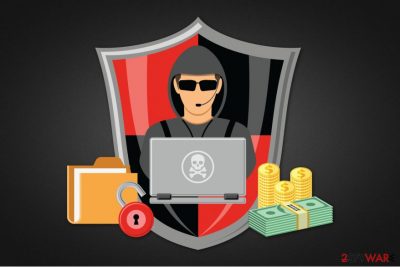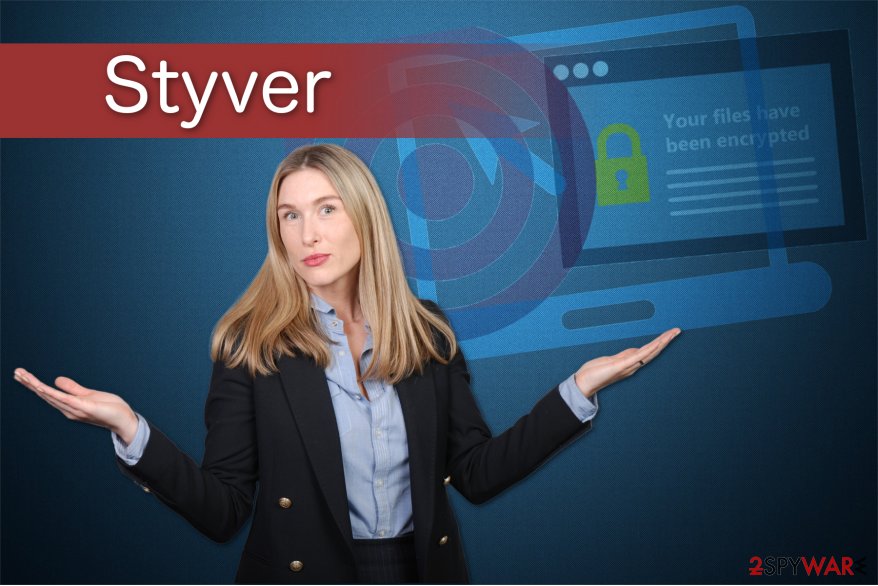Styver ransomware (Quick Decryption Solution) - Virus Removal Guide
Styver virus Removal Guide
What is Styver ransomware?
New Styver ransomware blackmails computer users

Styver is a ransomware-type computer infection which uses AES[1] algorithm to encrypt widely used data on the system. Later, the user is unable to access files with .styver extension and insisted on contacting the criminals via styver.goodman@aol.com email address. Information about the attack is provided in HELP ME PLS.txt file which serves as a ransom note. Unfortunately, the precise amount of the ransom is still unknown.
Data encryption is a sophisticated technique to protect information. Although, criminals exploit it for blackmail purposes. Likewise, data encoded by this file-encrypting virus cannot be restored unless the user has a unique Styver decryptor. Sadly, it can only be generated by the developers of the ransomware.
Here is the fraction of Styver's ransom note:
Hello. If you want to restore files, write me to styver.goodman@aol.com. Your userkey: XXX
However, do NOT rush to pay the ransom[2]! Keep in mind that the contrivers of Styver ransomware are criminals and should not be trusted. There are numerous reports by people who made the transaction and never received the decryption key or worse — were asked to pay even more. Thus, by paying the ransom, you would only finance malicious activity by the crooks.

Instead, we strongly suggest you remove Styver from your system. If you do so, you will be able to try alternative ways to recover your files without suffering from financial losses. You can find decryption methods presented at the end of this article. Make sure to try them all in order to recover most of your data.
For Styver removal we suggest you employ a robust antivirus software. Ransomware-type infections are highly dangerous and trying to uninstall them on your own might do even more damage to your system. Our top recommendations would be FortectIntego and Malwarebytes.
Reckless behavior online might lead to ransomware attack
The most common attack vectors are based on the behavior of non-attentive and credulous people. Usually, hackers distribute crypto-malware through malicious spam emails or fake software updates. Likewise, computer users who are browsing on shady websites or tend to click on content without inspecting it first are more likely to infiltrate ransomware on their systems.
Therefore, you should avoid opening spam letters. Note that criminals often impersonate emails from legitimate companies to trick you into opening the infected attachment. Sadly, the attached document is nothing more than a payload of the ransomware which might disguise as a fraudulent invoice.
Additionally, cybercriminals put fake software updates or cracks on peer-to-peer file sharing websites to lure people into downloading ransomware. For this reason, experts from ZonderVirus.nl[3] strongly advise you to download programs only from official sites and use a direct link if possible.
Styver virus uninstall guide
While regular computer users can get rid of potentially unwanted programs on their own, ransomware-type infections are not that easy to uninstall. In fact, Styver removal procedure requires specific IT knowledge and skills of an experienced computer user.
Likewise, you can only remove Styver with a professional antivirus software or get help from an IT expert. Be aware that security software is a long-term investment since it will serve as a precautionary measure in the future. Our top picks would be FortectIntego, SpyHunter 5Combo Cleaner, and Malwarebytes.
Getting rid of Styver virus. Follow these steps
Manual removal using Safe Mode
The first step to start Styver removal is to boot your PC into Safe Mode with Networking as shown below.
Important! →
Manual removal guide might be too complicated for regular computer users. It requires advanced IT knowledge to be performed correctly (if vital system files are removed or damaged, it might result in full Windows compromise), and it also might take hours to complete. Therefore, we highly advise using the automatic method provided above instead.
Step 1. Access Safe Mode with Networking
Manual malware removal should be best performed in the Safe Mode environment.
Windows 7 / Vista / XP
- Click Start > Shutdown > Restart > OK.
- When your computer becomes active, start pressing F8 button (if that does not work, try F2, F12, Del, etc. – it all depends on your motherboard model) multiple times until you see the Advanced Boot Options window.
- Select Safe Mode with Networking from the list.

Windows 10 / Windows 8
- Right-click on Start button and select Settings.

- Scroll down to pick Update & Security.

- On the left side of the window, pick Recovery.
- Now scroll down to find Advanced Startup section.
- Click Restart now.

- Select Troubleshoot.

- Go to Advanced options.

- Select Startup Settings.

- Press Restart.
- Now press 5 or click 5) Enable Safe Mode with Networking.

Step 2. Shut down suspicious processes
Windows Task Manager is a useful tool that shows all the processes running in the background. If malware is running a process, you need to shut it down:
- Press Ctrl + Shift + Esc on your keyboard to open Windows Task Manager.
- Click on More details.

- Scroll down to Background processes section, and look for anything suspicious.
- Right-click and select Open file location.

- Go back to the process, right-click and pick End Task.

- Delete the contents of the malicious folder.
Step 3. Check program Startup
- Press Ctrl + Shift + Esc on your keyboard to open Windows Task Manager.
- Go to Startup tab.
- Right-click on the suspicious program and pick Disable.

Step 4. Delete virus files
Malware-related files can be found in various places within your computer. Here are instructions that could help you find them:
- Type in Disk Cleanup in Windows search and press Enter.

- Select the drive you want to clean (C: is your main drive by default and is likely to be the one that has malicious files in).
- Scroll through the Files to delete list and select the following:
Temporary Internet Files
Downloads
Recycle Bin
Temporary files - Pick Clean up system files.

- You can also look for other malicious files hidden in the following folders (type these entries in Windows Search and press Enter):
%AppData%
%LocalAppData%
%ProgramData%
%WinDir%
After you are finished, reboot the PC in normal mode.
Remove Styver using System Restore
-
Step 1: Reboot your computer to Safe Mode with Command Prompt
Windows 7 / Vista / XP- Click Start → Shutdown → Restart → OK.
- When your computer becomes active, start pressing F8 multiple times until you see the Advanced Boot Options window.
-
Select Command Prompt from the list

Windows 10 / Windows 8- Press the Power button at the Windows login screen. Now press and hold Shift, which is on your keyboard, and click Restart..
- Now select Troubleshoot → Advanced options → Startup Settings and finally press Restart.
-
Once your computer becomes active, select Enable Safe Mode with Command Prompt in Startup Settings window.

-
Step 2: Restore your system files and settings
-
Once the Command Prompt window shows up, enter cd restore and click Enter.

-
Now type rstrui.exe and press Enter again..

-
When a new window shows up, click Next and select your restore point that is prior the infiltration of Styver. After doing that, click Next.


-
Now click Yes to start system restore.

-
Once the Command Prompt window shows up, enter cd restore and click Enter.
Bonus: Recover your data
Guide which is presented above is supposed to help you remove Styver from your computer. To recover your encrypted files, we recommend using a detailed guide prepared by 2-spyware.com security experts.If your files are encrypted by Styver, you can use several methods to restore them:
Download Data Recovery Pro to retrieve files with .styver extension
Experts strongly recommend using this tool not only in case of ransomware but also if you have lost your data during system crash.
- Download Data Recovery Pro;
- Follow the steps of Data Recovery Setup and install the program on your computer;
- Launch it and scan your computer for files encrypted by Styver ransomware;
- Restore them.
Try out Windows Previous Versions Feature
If you have previously turned System Restore on, feel free to recover encrypted files by using this in-built function.
- Find an encrypted file you need to restore and right-click on it;
- Select “Properties” and go to “Previous versions” tab;
- Here, check each of available copies of the file in “Folder versions”. You should select the version you want to recover and click “Restore”.
Use ShadowExplorer software for data recovery
Since there is no reliable information that Styver ransomware deletes or corrupts Shadow Volume Copies, you can try this tool.
- Download Shadow Explorer (http://shadowexplorer.com/);
- Follow a Shadow Explorer Setup Wizard and install this application on your computer;
- Launch the program and go through the drop down menu on the top left corner to select the disk of your encrypted data. Check what folders are there;
- Right-click on the folder you want to restore and select “Export”. You can also select where you want it to be stored.
Experts are still working on Styver decryptor.
Finally, you should always think about the protection of crypto-ransomwares. In order to protect your computer from Styver and other ransomwares, use a reputable anti-spyware, such as FortectIntego, SpyHunter 5Combo Cleaner or Malwarebytes
How to prevent from getting ransomware
Choose a proper web browser and improve your safety with a VPN tool
Online spying has got momentum in recent years and people are getting more and more interested in how to protect their privacy online. One of the basic means to add a layer of security – choose the most private and secure web browser. Although web browsers can't grant full privacy protection and security, some of them are much better at sandboxing, HTTPS upgrading, active content blocking, tracking blocking, phishing protection, and similar privacy-oriented features. However, if you want true anonymity, we suggest you employ a powerful Private Internet Access VPN – it can encrypt all the traffic that comes and goes out of your computer, preventing tracking completely.
Lost your files? Use data recovery software
While some files located on any computer are replaceable or useless, others can be extremely valuable. Family photos, work documents, school projects – these are types of files that we don't want to lose. Unfortunately, there are many ways how unexpected data loss can occur: power cuts, Blue Screen of Death errors, hardware failures, crypto-malware attack, or even accidental deletion.
To ensure that all the files remain intact, you should prepare regular data backups. You can choose cloud-based or physical copies you could restore from later in case of a disaster. If your backups were lost as well or you never bothered to prepare any, Data Recovery Pro can be your only hope to retrieve your invaluable files.
- ^ Margaret Rouse. Advanced Encryption Standard (AES). TechTarget. Computer Glossary, Computer Terms.
- ^ Harold Stark. When Attacked By Ransomware, The FBI Says You Shouldn't Pay Up. Forbes. American business magazine.
- ^ ZonderVirus. ZonderVirus. Security and Spyware News.





















